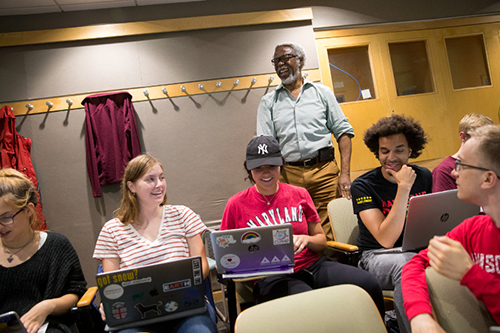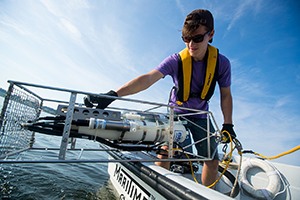PROVIDENCE, R.I. [Brown University] — When Sarah Bawabe arrived at Brown as a first-year student in fall 2017, she hadn’t given much thought to a physics as a potential concentration. That was before she took an introductory physics seminar called “Flat Earth to Quantum Uncertainty” with Brown physicist S. James Gates Jr.
“I vividly remember showing up to class and thinking that Professor Gates was the coolest person alive,” Bawabe said of the renowned theoretical physicist and National Medal of Science winner. “When I was a kid, I wanted to be an astronaut… so I had physics in the back of mind. But coming here, taking Professor Gates’ class and getting to see what physics was all about really solidified things.”
As a result of the class, which was originally created by Brown professor and Nobel Laureate Leon Cooper, Bawabe promptly declared a concentration in mathematical physics and asked Gates if he might have any summer research opportunities for her. As it turned out, he did.
For the past 19 years, Gates has led a program called the Summer Student Theoretical Physics Research Session (SSTPRS). For its 20th year, SSTPRS moved to Brown from Gates’ former academic home at the University of Maryland. The program gives undergraduates a chance to work side-by-side with him on big questions in theoretical physics. The ultimate goal is for students to eventually be co-authors with Gates on peer-reviewed journal papers — a major leg up for students thinking about graduate school.
Every weekday this past June, Bawabe and 19 other SSTPRS students from colleges around the country (and one student from Hong Kong) met in Barus and Holley, where Gates brought the group up to speed on his current research projects. Since 2004, he has been studying graphical representations of the mathematics underlying supersymmetry, a theory that helps to unite the fundamental forces that govern the universe. Those graphical representations, which Gates and his colleagues call adinkras, are pictures that encode the mathematics of how supersymmetric particles interact. The hope is that adinkras can provide scientists with a deeper and more intuitive understanding of the universe than equations alone.
But before that can happen, Gates needs to prove that adinkras are properly encoding the underlying math, and that’s what the SSTPRS students are working on. The work involves performing complex calculations — with pencil and paper as well as with the help of computers.
Bawabe admits that working with such arcane and occasionally dizzying math was a bit daunting for someone just finishing her first undergraduate year.
“You open one of these research papers and you see all these weird symbols and you just have to wonder what’s going on,” she said. “But after a few weeks I could start to decode it, and that was really satisfying.”
Over the course of the month, Bawabe said she became fluent in two mathematical coding languages and learned a range of new mathematical techniques. But more importantly, she says, she formed a new group of like-minded undergrads with whom she’ll continue to work. Now that they’ve completed the classroom portion of SSTPRS, the students will continue to collaborate and work toward publishing their work in a peer-reviewed journal.

“I learned so much from SSTPRS, not just about specific concepts, but also about what it’s like to really ‘do physics’ out in the world,” Bawabe said. “It was incredible being able to learn under Professor Gates and all of his collaborators. It’s especially rare that such knowledgeable people in the physics world take the time to teach us, work with us and truly have faith that even we undergraduates can contribute to their work.”
Bawabe said she would encourage other students with a love of physics to participate if they have the chance.
“This program changed my outlook on the world of physics,” she said. “Being a girl and often feeling intimidated by this male-dominated field, having the confidence to know I, too, can make it is a powerful and motivating feeling. I started in June feeling terrified about what I had gotten myself into, but at the end I walked away feeling like I was capable of more than I had given myself credit for.”
